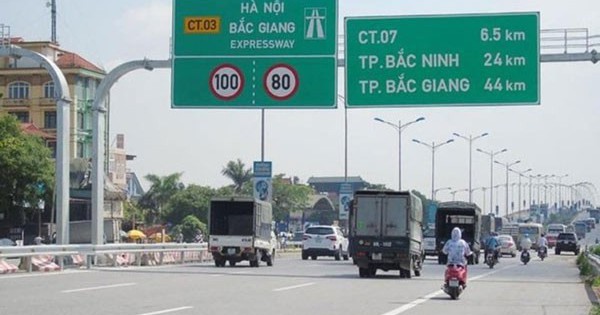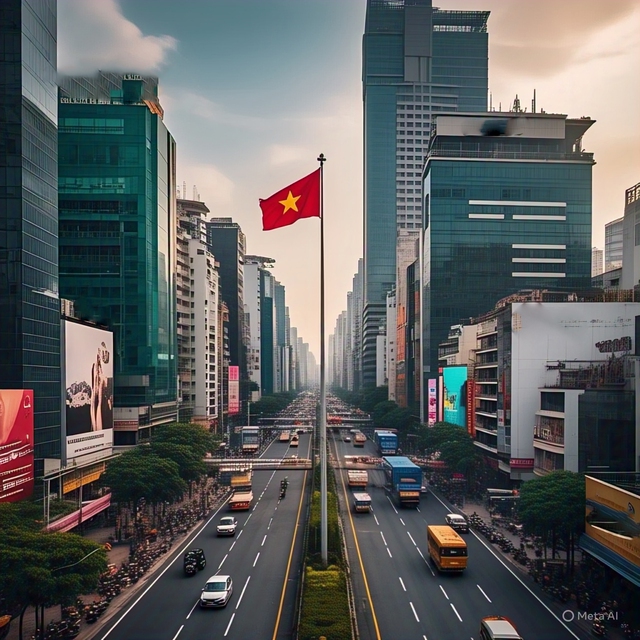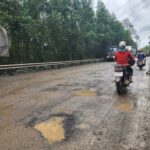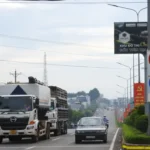Hanoi–Bac Giang Investment Joint-Stock Company has recently proposed to the Ministry of Construction and the Vietnam Road Administration to expand the Hanoi–Bac Giang expressway to a ten-lane highway.
This suggestion is made in the form of a public-private partnership (PPP) to meet the ever-increasing traffic demands and align with the approved transportation infrastructure development plan.
Justifying this proposal, the company stated that the current traffic volume at the toll station reaches approximately 53,500 vehicles per day and night. Meanwhile, according to the financial plan in the BOT contract, the saturated traffic volume of the route in 2022 was expected to be just over 46,000 vehicles per day and night. Notably, the number of vehicles has been increasing steadily at a rate of about 11% per year in the last three years.
“The surge in vehicle numbers has led to congestion, affecting the operating speed and causing frequent traffic jams. This situation also increases transportation costs and impacts the competitiveness of the region,” stated Hanoi – Bac Giang Investment Joint-Stock Company in the document.

The Hanoi–Bac Giang expressway, spanning over 46 kilometers, commenced operations in April 2016 and started toll collection the following month. The toll collection period is expected to last for 21 years. The route starts at Km113+985 on National Highway 1, located in Dĩnh Trì Ward, Bac Giang City, and ends at Km159+100, near the old Phu Dong toll station in Phuc Loi Ward, Long Bien District, Hanoi.
Designed as a high-speed expressway with an operating speed of 100 km/h, the route currently has four lanes. The section from Bac Giang to Nhu Nguyet Bridge has a roadbed width of 33 meters, while the section from Nhu Nguyet Bridge to Km159+258 has a roadbed width of 34 meters.
According to the Road Network Planning for the period of 2021–2030, with a vision towards 2050, approved by the Prime Minister, the Hanoi–Bac Giang–Lang Son expressway will have a total length of 137 kilometers and will be expanded to a six-lane highway. Specifically, the Hanoi–Bac Giang section, spanning 46 kilometers, is planned to be upgraded to an eight-lane expressway to accommodate the growing traffic demands.
The BOT project for renovating and upgrading National Highway 1, Hanoi–Bac Giang section, has a total investment of over VND 4,000 billion. The investors of this project are a consortium consisting of Van Phu Investment Joint Stock Company, Dong Son Infrastructure Investment Joint Stock Company, Vietnam Construction and Import-Export Corporation (Vinaconex), and Ocean Group Joint Stock Company.
This project not only contributes to enhancing the transportation capacity on the northern gateway route of the capital but also plays a crucial role in connecting the midland and mountainous areas of the North with the key economic region of the North.

Vietnam aims to complete 5,000 kilometers of expressways by 2030. Illustration by AI.
Regarding the development of the expressway system, Vietnam has set an ambitious target to finish 3,000 kilometers of expressways by 2025. To achieve this goal, 28 projects and sub-projects managed by the Ministry of Transport and local authorities are being actively implemented.
“With the target of 3,000 kilometers by 2025 and 5,000 kilometers of expressways by 2030, we are determined to turn Vietnam into a developed industrial country. This is a critical strategy to boost our competitiveness, and we are committed to overcoming the challenges ahead,” shared Dr. Dao Huy Hoang from the Institute of Science and Technology for Transport under the Ministry of Transport.
He emphasized the importance of a seamless road network to prevent bottlenecks and ensure smooth transportation. “As we step into a new era for our nation, it is imperative that we achieve the goal of 5,000 kilometers of expressways by 2030,” he added.
The New and Improved Highway: Expanding to 12 Lanes with an Overpass
The traffic volume has long exceeded the designed capacity, resulting in frequent congestion on the Phap Van – Cau Gie highway. In response, the highway management unit has proposed to expand the road from six to twelve lanes. On March 27th, the investor’s representative announced that they would construct elevated bridges on both sides to accomplish this expansion.
The Hanoi Expansion: Widening Quang An Road to a Whopping 21 Meters
The Hanoi authorities have approved the proposal to construct a water transport hub and bridge connecting Ho Thuy Tu and Dam Tri. This development will include improved transportation systems, static traffic solutions, pedestrian walkways, and a focus on enhancing the surrounding landscape and treating wastewater in the iconic Ho Tay area.
Vingroup and Techcombank Explore Feasibility Report for Gia Nghia-Chon Thanh Expressway
On November 30, the People’s Committee of Binh Phuoc Province issued a dispatch concerning Component Project 1 of the North-South Expressway Western Route Project, specifically the Gia Nghia (Dak Nong) – Chon Thanh (Binh Phuoc) section, hereinafter referred to as the Gia Nghia – Chon Thanh Expressway.
Unlocking the Potential: Elevating Ho Chi Minh City’s Transport Network with an Overpass Expansion Project Worth 35,000 Billion VND
National Highway 13, the North-South axis, the Binh Tien bridge and road are three of the five key gateway expansion projects undertaken in a Build-Operate-Transfer (BOT) format, as per Resolution 98, piloted by Ho Chi Minh City.





















